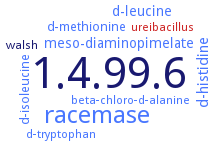1.4.99.6: D-arginine dehydrogenase
This is an abbreviated version!
For detailed information about D-arginine dehydrogenase, go to the full flat file.

Reaction
Synonyms
D-alanine dehydrogenase, D-amino acid dehydrogenase, D-amino acid dehydrogenase DadA, DAADH, DAD, DadA, DADH, DauA, EC 1.4.99.1, NADP+-dependent D-amino acid dehydrogenase
ECTree
Advanced search results
Engineering
Engineering on EC 1.4.99.6 - D-arginine dehydrogenase
Please wait a moment until all data is loaded. This message will disappear when all data is loaded.
A46G
mutation in loop L1. Probability of being in open conformation is higher than that of wild-type, yielding an increased level of solvent exposure of the active site. The flavin fluorescence intensity is about 2fold higher than in wild-type. Loop L1 is important for substrate capture and catalysis
E87L
kcat/Km pH-profile of the E87L mutant indicates only a single unprotonated group is required for maximal activity with D-arginine. E87 is the unprotonated group on the enzyme that binds cationic substrates
S45A
mutation in loop L1. Probability of being in open conformation is higher than that of wild-type, yielding an increased level of solvent exposure of the active site. The flavin fluorescence intensity is about 2fold higher than in wild-type. Loop L1 is important for substrate capture and catalysis
Y249F
Y53F
steady-state kinetic parameters similar to those of the wild-type enzyme. Rate constants for flavin reduction (kred) with D-leucineare 3fold smaller than the wild-type value with similar pKa values for an unprotonated group of about 10.0. Cleavage of the substrate NH and CH bonds in the enzyme variant occurs in synchronous fashion, which can be reconciled with a hydride transfer mechanism
A46G
-
mutation in loop L1. Probability of being in open conformation is higher than that of wild-type, yielding an increased level of solvent exposure of the active site. The flavin fluorescence intensity is about 2fold higher than in wild-type. Loop L1 is important for substrate capture and catalysis
-
S45A
-
mutation in loop L1. Probability of being in open conformation is higher than that of wild-type, yielding an increased level of solvent exposure of the active site. The flavin fluorescence intensity is about 2fold higher than in wild-type. Loop L1 is important for substrate capture and catalysis
-
steady-state kinetic parameters similar to those of the wild-type enzyme. Rate constants for flavin reduction (kred) with D-leucine are 3fold smaller than the wild-type value with similar pKa values for an unprotonated group of about 10.0. Cleavage of the substrate NH and CH bonds in the enzyme variant occurs in synchronous fashion, which can be reconciled with a hydride transfer mechanism
Y249F
mutant protein shows both an active yellow FAD (Y249F-y) and an inactive chemically modified green 6-hydroxy-FAD cofactor. Variants show no differences in the overall protein structure and fold. Variant Y249F-y displays an alternative conformation for some active site residues and the flavin cofactor. Y249F-y with FAD samples a metastable conformational state, not available to the wild-type enzyme. The alternate conformation in the Y249F-y enzyme is responsible for the higher spin density at the C6 atom of flavin, consistent with the formation of 6-hydroxy-FAD


 results (
results ( results (
results ( top
top






